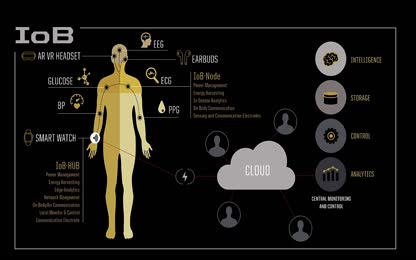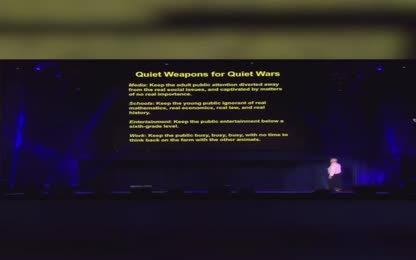Advertisement
Defeating Microwave Weapons! - tech ingredients themtoob channel
some useful and easy to follow information on how the LRAD and many other microwave radiation weapons systems work, and how to defeat them with simple counermeasures
- Category: Uncategorized
- Duration: 29:28
- Date: 2022-07-27 05:34:32
- Tags: lrad, dew, microwave radiation, emrf, silent weapons for quiet wars, government terrorism, war, terrorism
11 Comments
Video Transcript:
Hi, last year we did a series of videos on LRAD, L-R-A-D, which stands for Long Range Acoustic Devices. It's a beautiful fall day here in New England. Recently there's been a lot of interest in this because of all of the protests that are occurring around the world. And we've gotten a lot of questions as to whether or not some of the injuries that have been reported by people who participated in those protests, whether or not they could be due to an LRAD device. By definition an acoustic device attacks the ear. The target is the ear. Whether it's through the ear canal or through the bones around the ear, it is an overwhelmingly painfully loud sound. It isn't stealthy. And the kinds of injuries that were reported, I've seen the videos and I've read the reports. They're not consistent with that. There's facial swelling, there's swelling of the lips, the eyelids, there's burns, blisters. And acoustic device is not going to do that. Even if you could up the energy to incredible levels to injure the skin or burn the skin, you'd have to use so much power that you'd make everybody instantly deaf. So it's unlikely that it was an acoustic device that did that. The injuries are also not consistent with chemical burns. Any kind of an irritant that could irritate the skin, injure the dermis to the point that you form burns, is going to do an order of magnitude more harm to the mucus membranes in the eyes, the mouth, the respiratory tract. You'd have coughing, people would be complaining of shortness of breath, and you don't see those kinds of reports. The injuries are, however, consistent with a microwave attack. And there are microwave weaponized microwave systems designed for what's called L-R-A-D, which is the same series of letters, but stands for long range area denial. They're built by military contractors. There's even some websites and some YouTube videos by some military contractors who produce these systems. Raytheon is one. So they do exist, and it is plausible they may have been used in some of these protests. I find that very troubling because even the most powerful microwave weapon is not a battlefield weapon. It won't take out a T90 tank. It won't even be able to take out a few infantry men with high-powered rifles because the range of these devices is rather limited. So these devices are actually used for lightly armed or unarmed civilians. They're used by governments on their own citizens, and that's what I find so troubling. So today what we're going to do is we're going to cover the use of microwaves, their interaction with different types of materials, and then jump right ahead to a means of defending yourself or defeating a microwave attack. So the way microwaves work is they interact with water molecules. All electromagnetic radiation consists of photons and an associated electric field, a sinusoidal varying electric field. And because water molecules are dipoles, they're asymmetric. When a microwave interacts with a water molecule, it causes the water molecule to attempt to flip to align itself with that varying magnetic field. When a microwave oven, that field is varying at about 2.5 gigahertz or 2.5 billion times per second. That flipping of the water molecule creates frictional heating transfers that heat to the non-responsive solids in the food and cooks your dinner. The problem though in terms of a weapon system is that the microwaves interact at that frequency moderately or modestly with the water. It takes a lot of water molecules to absorb some of that energy of the microwave as it's penetrating. So the microwaves penetrate deeply, which is good if you're cooking a pot roast or a casserole, you want the heat deposited deeply within the food. But a microwave oven operates at a low frequency, while a weaponized microwave system operates at a far higher frequency between 80 and 120 gigahertz. So instead of a 12.5 centimeter wavelength, the wavelength is down around 3.2 millimeters. Because it's flipping those water molecules 100 billion times per second, there's much more energy deposited in each water molecule. As a consequence, you don't need very many water molecules to absorb all the energy, and so all the energy is deposited in the outer layers, the outer one millimeter or so of the target tissue. From a weapon's point of view, that's a good thing. Because if you're trying to create pain or injury, it takes a lot more energy to elevate the temperature of a large amount of tissue, if you have to go deeply into the tissues, a lot of mass there. But if all of that energy is deposited in the top millimeter or so of the very nerve-rich skin, you don't need much energy to cause the pain or the injury. The second advantage of the very high frequency of militarized systems has to do with optics. The ability for you to focus or collimate that beam of energy is related to the relative size of those optics compared to the wavelength. It's not the actual physical size of the reflective optics or the horns or the antennas. It's the size relative to that wavelength. So for a given size set of optics, the higher frequency has a shorter wavelength and can be better focused, better collimated, and sent farther down field. So you're able in a weaponized system to send more energy farther and you need less energy to cause the pain that's associated with that aerial denial. The problem with the weaponized systems or the high frequency systems is that they're difficult to build, they're difficult to test because obviously you need to work with very, very high frequencies. However, the difference between the microwave-based system and the weaponized system is merely a matter of scale, the same principles apply. And so what we're going to do is we're going to demonstrate the effect of microwaves on systems here and then we're also going to show how to defeat them and we're going to use a low frequency or a microwave frequency projector to do that. Now if you're interested in these sorts of systems, there are a lot of YouTube videos out there that show you how to build these things. They're really easy to do. And in order to do that, you need to find an old microwave, not a new one. The reason being is that old microwaves depend on old-fashioned step-up transformers. The newer microwave systems, they depend on high frequency switching power supplies and they have a lot more feedback loop with the controlling electronics. They're harder to hack. To find an old microwave is pretty easy to do, you pick it up because this transformer is a solid block of steel and it weighs almost as much as the rest of the microwave oven combined. So when you pick it up, you'll notice that the side behind the control panel is far heavier than the rest of the microwave. That's a good giveaway. Secondly, because it's so heavy, these transformers are mounted on the bottom of the microwave at four screw positions, about 100 millimeters apart in a square pattern. If you see those four screws on the bottom of an old microwave or a heavy microwave, you've got an old microwave. Bring it home, take off the sheet metal covering and you'll see several components like this and then a whole bunch of electronics and little wires and dilly bits and lights. What makes this so easy to do is that once you cut away all of the drawths, the other stuff that you're not going to need, you can remove these major components as they are wired up in the microwave. You never have to disconnect them so you don't even need a circuit diagram to build one of these things. The first thing is obviously the transformer. What this does is it takes line frequency AC power, whether it's 120 or 220, that depends on how much you're going to step this up. But in both cases, the output from the transformer will be an AC 2000 volt current or voltage coming out of the transformer. It's then passed to a half wave rectifier, which involves a capacitor and a rectifier. What that does is it changes the AC current or voltage that's coming out of the transformer and it flips it so that you're producing a DC train of pulses at twice the line frequency. If this is 50 hertz, you go to 100 hertz. If it's 60 hertz, you go to 120 hertz and it doubles the voltage. What comes out of this part of the circuit is 4000 volts that goes into the cavity magnetron. Cavity magnetron is basically a vacuum tube and the way it operates is that there's a thermionic emitter inside of the cavity that when heated up causes minerals to release a huge quantity of free electrons. In a magnetic field created by a permanent magnet attached to the bottom of the magnetron tube, these electrons begin to spiral around and when electrons are accelerated, what happens is they produce an electromagnetic radiation at right angles to their acceleration. Inside the tube that contains that sort of spiraling electron doughnut, there are little fins that are mounted on the outer wall. They look almost like the inside of an internal gear. These tend to intensify the electric field inside of the magnetron and produce a much more efficient output of microwaves which come out of the end of the tube. Those microwaves are then directed by a wave guide. The wave guides are often attached with some spot welds to the inside of a microwave chamber, the inside where you cook. You might have to drill those out to get that off but it'll take you five minutes. The wave guides simply redirects the radiation coming out of the end of the tube and gathers it all toward a little opening that then would spill into the microwave interior. The final part of this that needs to be constructed is the horn. The radiation without any kind of a horn here would radiate in an almost 180 degree field around here and be very, very diffuse and also difficult to protect yourself from. What the horn does is it tends to make the radiation more directional. It also acts as an impedance match. When the high frequency radiation exits the wave guide, if it exits immediately into free space, there's a lot of reflection at that point and some of that energy is sent back into the tube, creating more heating and less output. By creating a diverging opening to a larger opening, you decrease that reflection. It's an impedance match. The design of the horn is very loose. These things come with divergent angles anywhere from about 10 to about 50 degrees. What I mean by divergent angle is the full included angle of both sides of this horn. In this case, which is a 30 degree divergence, it's 15 degrees and 15 degrees, a 30 degree included angle in the horn. The length is pretty irrelevant. The longer the horn, the better the protection against lateral radiation and also slightly less divergence downfield, but it's a small difference. If we were to make this horn twice as long or half as long, it would operate almost as effectively. The hornized systems work by a different method. They can't operate with these bulky cavity magnetrons. The way they operate is they take a flat array of a whole number of very high frequency moderate energy emitters and by electronically slightly varying the phase relationship between the individual emitters, they can cause downfield, constructive and destructive interference that allows it to focus the beam as well as to electronically steer the beam. It's exactly how phased array radar works. It's compact, it's very effective and it combines the energy of many, many emitters into one single beam. Now that kind of construction is beyond me. I can't do that. One of my sons probably could do that, but I don't think he'd want to undertake a project that big and also there's the ethics involved. So we're not going to deal with a weaponized microwave system. We're going to deal with this projector here and just understand that the microwaves that are produced by this are only different from the weaponized microwaves by scale. Power, this thing produces about 1200 watts of output from about 1500 watts of input and the military versions probably produce at least tens of kilowatts. But again, it's just a matter of scale. So we're going to start out by demonstrating just how this thing works. And so let me get set with some tubing. All right, so I have two fluorescent tubes. What we're going to do is just show you that it's producing radio frequency output. We can also show you a little bit about the divergence of the beam from this horn to give an idea of where it's going. You'll also notice this little fan over here. You'll hear this run simply because the magnetron makes a lot of heat and to keep it cool we have to run a fan on the side of it. You want to go ahead and plug it in? Now watch the width of the illuminated part on the tube as they get farther and farther away. It's diverging. It's almost getting my hand at that point. So there's a pretty broad divergence of the beam. You can see it lights up all different kinds of fluorescent tubes. But you can see it has a rather limited range because the energy is diverging very rapidly. Now with nothing to obstruct the beam, you can see that the fluorescence here will continue until we get to about a little over a meter, maybe about four feet or so. And then we lose the light. This light is caused by the microwaves interacting with the mercury inside the tube and it elevates the outer electrons in the mercury, causing them to reach higher energy levels. And when they settle back down to the ground state, they release photons, UV photons that stimulate the phosphor inside of the tube to cause it to glow white. Now I'm going to demonstrate how much power this actually makes. Okay as I said, the microwaves interact with water. So I took a towel and I just wet the towel to make it damp. And then we're going to put this in front of the microwave, output. And we're going to watch what happens. All right, here we go. Now you can see the steam rising from the wet towel. And remember because these are long microwaves, long frequency or low frequency microwaves, the interaction with that water in the towel is rather limited. Most of the heat is actually passing right through the towel in a normal microwave because it's an enclosed container. Those microwaves will bounce back and forth going through the towel multiple times until eventually the energy is absorbed. So even with just a small fraction of the energy being absorbed, we're boiling the water off. All right, now the towel obviously got hot enough to steam. What I've done is I put a few pieces of Polish ham lunch in the same frame. And I want to see what the microwave which was designed to cook ham does to it. It smells like high quality spam. Yeah. I think like anything without spam in it, well, spam egg sausage and spam, there's not much spam in it. I don't want any spam. What's your bacon spam and sausage? It's got spam in it, so as much as spam egg sausage and spam. Look, could I have egg bacon spam and sausage without the spam? Yeah. What a weird gig, huh? Most people like they have a desk job. We're filming bacon being microwaved, but externally. It's definitely the way of the future called Gordon Ramsay. You just can't get in front of it or else, well, make it some cancers to yours. So we don't know actually what will happen to you. So you can see it did a number on the ham. And again, only a very small fraction of the energy was absorbed by this thin level layer of ham. Mmm. Crunchy. But it's good. Yeah, it's really good. Now, let's see if we can block the radiation, protect you from it. Obviously, it's got some power. All right. So now, let's see if we can protect ourselves. Remember, water does absorb microwave energy, even though this is the long wavelength, and it penetrates deeply into a wet medium. If we take a couple of wet towels, a thickness of moist towels that I've just soaked in the sink, and we put this in front, we're going to see if it affects the ability of this to drive the microwave, to drive the fluorescent tube. So turn it on. Let's see what happens. Now remember, when I hold this in front, it fluoresces. And as I move this away from the source, you can see that it works out to about, oh, heck, almost two meters here. It's pretty far. But if I place the water barrier in front like this, no fluorescence. If I start this up first, and then block it, you'll see that the energy cuts out about halfway as far away. Again, all the way out to about here, all the way out to about here, probably two meters almost. But if I place this water barrier here, and then try to drop the tube, it goes out in about a meter. So this doesn't absorb all of the energy, but the water does absorb even the low frequencies, significantly. And if we had the higher frequencies, this would be a complete protection. What's nice about that is that if you were potentially facing a microwave attack, if you just had a couple of water bottles and a towel, you could hold it in front of your face, and you'd probably protect yourself from a weaponized microwave system. And if you're thinking, well, that'll protect my face, but not the rest of me, just get a beach towel, flood it with water, hold it up in front, and you could dance away, and you're perfectly safe, easy, compact, and certainly not a threatening defense system. The other way that we can potentially protect ourselves is taking advantage of the microwave interaction with metal. Any kind of a conductor will act as an antenna and will actually reflect the energy from the microwave back towards source. So let me show you how that works. All right, next test. This is some thin sheet metal, and the microwaves will reflect off of the metal. And again, we should be able to block the energy simply by placing the metal between the source of the microwaves and the fluorescent tube. Turn the buddy on. Now you can see the light flushing. Watch what happens when I drop the metal in the way. Turns it right off. Turns it on. Very effective. I'm now going to show you how it can reflect the energy to a new location. It doesn't just absorb it, it reflects it. All right, so what I'm going to do is demonstrate the lateral aspect of the distribution of the microwaves. And so you can see that in order for this to glow, it pretty much has to be almost at the edge of the antenna. But once you get not even to the edge of the table, it dies off. I'm now going to put a metal reflecting plate in front like that to redirect the light this way. And we can see when I put this in front, how much farther laterally the radiation goes. This is working as a deflector, not just blocking the radiation and protecting my parts, but sending the radiation laterally. Okay, next. Now sometimes you're not going to have access to a great big metal plate to protect yourself. So a trick would be to take a poster with some sort of a theme or something interesting on it like this and laminate between the two surfaces, some aluminum foil. So you've got metal in between the two layers of plastic. And this will also block the radiation. So if I set this in here like this, you can see that it glows. Now when I place this in front, it kills it. Can you see that? Yep. Now another property of microwaves and their blockage by metal or any kind of conductor is that microwaves or any kind of electromagnetic radiation cannot pass through a space smaller than its wavelength. In this case, about 12 and a half centimeters. That's why this is the old haped door from the microwave that I got this from. That's why they put these metal screens in the door. The door itself is made out of plastic and wouldn't block the microwaves from getting out. But these perforated screens allow you to see through them. But at the same time, they block the radiation. So what we're going to do now is try a perforated metal screen like this. I've applied this screen to our riot shield. And this has a couple of advantages. First of all, you can see through it. You retain the protection of the riot screen, but also protect yourself from the microwave. So let me show you how this works. Now this is where I get a little daring. Okay. This is the fluorescent tube and it clearly glows. But if I take this screen and I put it in front of the beam like this, I'm standing in the microwave beam and it's protecting me. But not here. Here. But not here. And I feel fine. In addition, the metal will actually support a voltage. That's how some of the energy is handled by the microwave. Some of it is reflected. Some of it is absorbed. The point is that because this perforated surface allows me to see through it and because it's convex relative to the beam, the energy that's being deflected off of this to the sides. See if we can get this to go. Is spread out. And so as a result, you don't burn your friends who may be standing around you because you've made the energy far more diffuse by the time that it would get to the back sides of anybody around you, which is kind of a nice touch. We're not trying to weaponize anything here. But again, I feel fine. Just make sure that when you do use the screen, it's aluminum screen. Not the fiberglass that most modern window screens are made out of. It needs to be in aluminum. And finally, there is a small voltage that can develop in the conductors here. But it's small enough and it is lost in the resistance of the aluminum so that you can touch this and you don't get a shock. Pretty neat, huh? So those are some interesting tests. We've demonstrated that you can effectively block microwaves by absorbing them as we did with the wet towel. Or you can reflect them with a solid piece of conductive material like a plate or like a stealthy piece of aluminum foil placed on the backside of a poster which you might be carrying if you're going to some sort of a protest. In addition, you can also block it with a perforated conductor like aluminum window screen. And this also has the advantage that you can see through it. And because of the convex surface, we'll diffuse the energy so that you pose less of a risk to the people around you. Kind of a nice thing to keep in mind. In any case, I want to hope that you stay safe. And we really appreciate your spending your time and watching. If you have any comments or have any questions, put them down in the comments section below because I read them all and I try to answer as many questions as possible. And you also give me some good ideas for future videos. The best thing you can do for our channel if you like the kind of material that we cover here is to subscribe because by subscribing, we grow. And as we grow, YouTube will distribute our videos to a wider audience. And it helps us to support us for all of the time and the money that we spend to make these videos. In any case, stay safe, have a wonderful evening, and we'll see you soon.










 Donate
Donate







